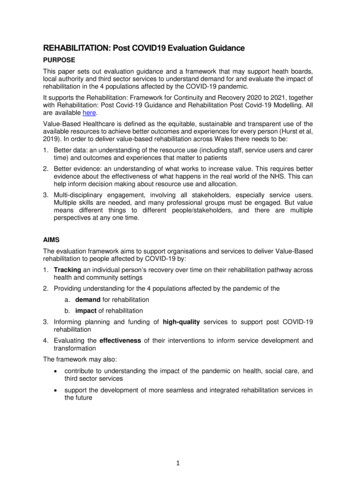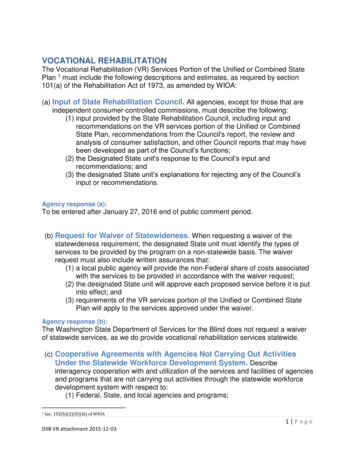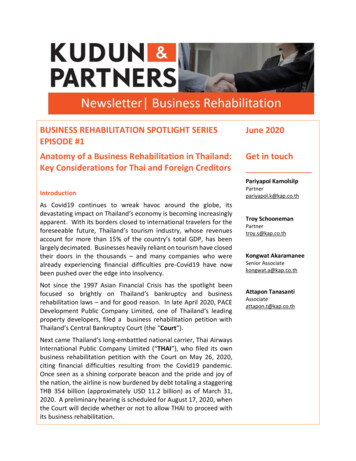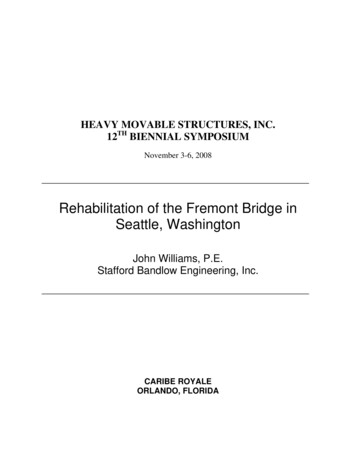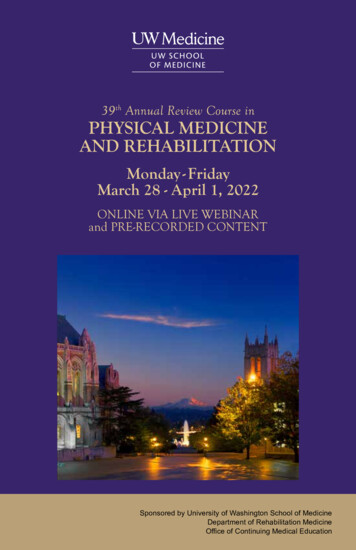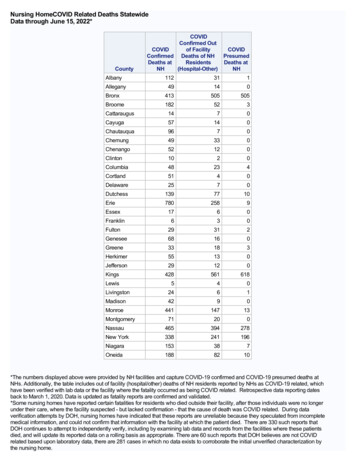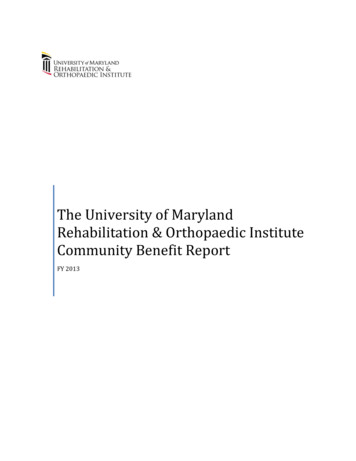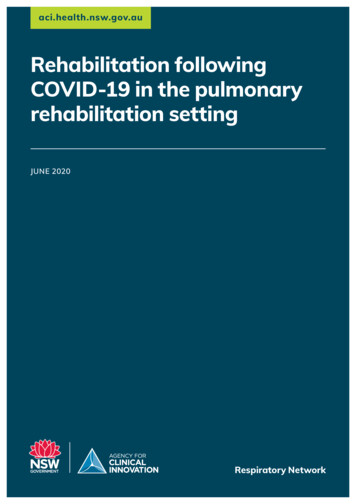
Transcription
aci.health.nsw.gov.auRehabilitation followingCOVID-19 in the pulmonaryrehabilitation settingJUNE 2020Respiratory Network
The information is not a substitute for healthcare providers’ professional judgement.Agency for Clinical Innovation1 Reserve Road St Leonards NSW 2065Locked Bag 2030, St Leonards NSW 1590T 61 2 9464 4666 F 61 2 9464 4728E aci‑info@health.nsw.gov.au www.aci.health.nsw.gov.auProduced by: Agency for Clinical Innovation Respiratory Network Pulmonary Rehabilitation ClinicalExpert Reference Group (PuReCERG). Professor Jennifer Alison (University of Sydney, Sydney LHD),Dr Renae McNamara (University of Sydney, Woolcock Institute of Medical Research, South EasternSydney LHD), Clinical Associate Professor Lissa Spencer (Sydney LHD), Dr Sally Wootton (NorthernSydney LHD), Associate Professor Zoe McKeough (University of Sydney), Dr Marita Dale (Universityof Sydney), Dr Ling Ling Tsai (South Eastern Sydney LHD), Helen Kulas (Respiratory NetworkManager ACI).Further copies of this publication can be obtained from the Agency for Clinical Innovation websiteat www.aci.health.nsw.gov.auDisclaimer: Content within this publication was accurate at the time of publication.This work is copyright. It may be reproduced in whole or part for study or training purposes subjectto the inclusion of an acknowledgment of the source. It may not be reproduced for commercialusage or sale. Reproduction for purposes other than those indicated above, requires writtenpermission from the Agency for Clinical Innovation.Preferred citation: NSW Agency for Clinical Innovation. Rehabilitation following COVID-19 in thepulmonary rehabilitation setting. Sydney, NSW: ACI; 2020.SHPN (ACI) 200521ISBN 9978-1-76081-468-7.Version: V1; ACI 0474 [09/20]Trim: ACI/D20/1314 State of New South Wales (NSW Agency for Clinical Innovation) 2020.Creative Commons Attribution No derivatives 4.0 licence.
Rehabilitation following COVID-19 in the pulmonary rehabilitation setting June 2020ContentsIntroduction and background 1Disease severity and progression 3Rehabilitation in the acute phase during hospital admission 4Rehabilitation in the recovery phase following hospital discharge 5Rehabilitation options following hospital discharge 6Conclusion 17References 18Appendices 21Acknowledgements 27Agency for Clinical Innovation www.aci.health.nsw.gov.au
Rehabilitation following COVID-19 in the pulmonary rehabilitation setting June 2020Introduction and backgroundThis document provides a guide for pulmonaryrehabilitation programs in delivering rehabilitationwithin existing programs (outpatient or communitysettings) for people recovering from COVID-19 whohave persistent impairments that would respond topulmonary rehabilitation.To date, little has been written about the role ofpulmonary rehabilitation in the recovery of peoplewith COVID-19 in the Australian healthcare context.However, as COVID-19 is primarily a pulmonarydisease, if people have persistent symptoms andimpairments following an acute phase of the disease,pulmonary rehabilitation programs may be anappropriate setting for rehabilitation.1Peer-reviewed literature about how best to providerehabilitation for this group is still emerging.1, 2 Asmore people survive and recover from the virus,additional impairments and responses to pulmonaryrehabilitation may be identified.In May 2020, the NSW Agency for ClinicalInnovation’s Respiratory Network PulmonaryRehabilitation Clinical Expert Reference Group(PuReCERG) began to develop this guidancedocument to assist pulmonary rehabilitationclinicians across NSW when they have receivedreferrals for pulmonary rehabilitation for patientsrecovering from COVID-19.On 11 March 2020, the World Health Organizationdeclared the COVID-19 (novel coronavirus SARSCoV-2) outbreak a pandemic. In Australia, there wasan initial sharp rise in the numbers of peoplediagnosed with COVID-19. However, with earlyborder control, rigorous and readily available testingand contact tracing, social distancing and isolationmeasures, the virus has not reached the prevalencerate that was initially expected in New South Wales(NSW). While Australia and NSW have relativelyfew cases compared with other countries, we havethe opportunity to learn from other countries aboutthe management of the condition in both the acuteand recovery phases.Agency for Clinical InnovationA rapid review of the available evidence wasundertaken by the NSW Critical Intelligence Unitand an evidence review produced. Additionalpeer-reviewed papers that have been published asemerging evidence since this evidence check werealso taken into consideration. Criteria for assessingthese included credibility of authors, inclusion ofpapers in high impact journals, availability of anysystematic reviews, and validation of any suggestedtools within the Australian PulmonaryRehabilitation Guidelines and PulmonaryRehabilitation Toolkit.1 www.aci.health.nsw.gov.au
Rehabilitation following COVID-19 in the pulmonary rehabilitation setting June 2020Synthesis of any emerging additional evidence wasundertaken collaboratively by the PuReCERG, whoused their academic and clinical expertise to achieveclinical consensus for literature and tools that wouldbe used to support the development of this guide.Any relevant NSW Health guidance on the treatmentand management of COVID-19 was also used tocomplement the guidance provided within thisdocument. The document was then peer reviewed byexperts in pulmonary rehabilitation and the‘treatable traits approach’ described below.This document was prepared using a ‘treatable traitsapproach’, which allows for the recognition ofclinically important, identifiable and treatabledisease characteristics, followed by targeted andindividualised treatment interventions to addresseach trait. 3Such an approach aims to assist pulmonaryrehabilitation clinicians to identify, assess andprovide appropriate individually designed pulmonaryrehabilitation programs for people recovering fromCOVID-19. While the document focuses onrehabilitation that can be provided within apulmonary rehabilitation program, there may be theneed to refer people recovering from COVID-19 toother specialised rehabilitation programs, such ascardiac, neurological or general rehabilitationprograms.Agency for Clinical Innovation2 www.aci.health.nsw.gov.au
Rehabilitation following COVID-19 in the pulmonary rehabilitation setting June 2020Disease severity and progressionExperiences from Europe and China have found theseverity of COVID-19 can vary greatly betweenpeople. Approximately 80% of people have beenreported to have mild disease, 14% have severedisease and the remaining 6% have been reported tohave critical illness.4-6The effect of COVID-19 will vary greatly over thecourse of the disease, with most people experiencingsome of the following symptoms: fever, cough,fatigue, anorexia, shortness of breath, sputumproduction, myalgia, central nervous systemmanifestations (such as headaches, migraines,dizziness and ataxia), and peripheral nervous systemmanifestations (such as nerve pain, speech, visionand taste problems).1,4-6 While some of thesesymptoms may resolve naturally, some people mayhave impairments that persist; particularly followinga prolonged hospital and ICU stay.Of people with COVID-19 who have beenhospitalised, 20–25% of cases in Europe and26–32% in China required admission to an intensivecare unit (ICU) for a prolonged period, with a medianICU stay of 10 to 13 days.4-6 People with severeCOVID-19 require supportive management forpossible complications from viral pneumonia, whichmay develop into acute respiratory distresssyndrome (ARDS), acute hypoxaemic respiratoryfailure, septic shock and multi-organ failure.4-6In the recovery period, people with COVID-19 maybe expected to present with significant musclewasting in both the locomotor and respiratorymuscles. This may contribute to ongoingbreathlessness and fatigue, reduced exercisecapacity, poor balance and loss of functionalindependence.7,8 .Medical management also includes stabilisingcomplications, such as thromboembolism,gastrointestinal bleeding and critical illnesspolyneuropathy/myopathy.4,6 Chest x-ray andcomputerised tomography (CT) scans have shownlung infiltrates; and in the longer term, lung fibrosismay occur in some people. Currently, caution needsto be observed for lung function testing due toinfection risk (please refer to the ACI Lung functiontesting: COVID-19 advice for further information), sothe long-term effects of COVID-19 on loss of lungvolumes and diffusion capacity are currentlyunknown.Agency for Clinical Innovation3 www.aci.health.nsw.gov.au
Rehabilitation following COVID-19 in the pulmonary rehabilitation setting June 2020Rehabilitation in the acute phaseduring hospital admissionEarly rehabilitation intervention is paramount toimproving patient outcomes. During the acute phaseof COVID-19, early rehabilitation in the form of amultidisciplinary in-reach program is recommendedto commence rehabilitation from the time of ICU orward admission. This multidisciplinary inpatientrehabilitation can help manage extra-pulmonarymanifestations.Each local health district will have a differentprotocol for the treatment of inpatients with severeCOVID-19. Some will advise that there should beminimal allied health contact with ICU patients,unless absolutely necessary. Statements haverecently been published providing guidance on thephysiotherapy management and occupationaltherapy management of people with COVID-19 inthe acute setting.2,11Early rehabilitation in the form of active mobilisationhas been recommended; however, patients need tobe medically stable before commencement of gentleexercise training, and rehabilitation staff need to beappropriately skilled.5,7,10,11When a person is hospitalised with COVID-19, thereis a risk of the spread of the virus to others and caremust be taken to protect staff and other patients. Allinterventions and activities must be performed toavoid or reduce the risk of droplet production andaerosol generation.7 Please refer to the ACIRespiratory physiotherapy COVID-19 advice forfurther information.Agency for Clinical Innovation4 www.aci.health.nsw.gov.au
Rehabilitation following COVID-19 in the pulmonary rehabilitation setting June 2020Rehabilitation in the recovery phasefollowing hospital dischargeEach person with COVID-19 will follow a differentrecovery journey. Some will require an intensiverehabilitation program to fully recover following ahospital and ICU stay, while others with mild diseaserequire no rehabilitation at all. It is unclear if allpeople who have had COVID-19 (hospitalised or not)will have physical and/or psychological impairmentsand how they will respond to treatment.1,5 There maybe a period of natural recovery, especially in relationto fatigue.Two recently published documents from theChartered Society of Physiotherapists (UK)12 and theBritish Thoracic Society1 have recommended thatrehabilitation programs need to be: flexible and well planned based on a thorough initial assessment with theidentification of impairments followed by a seamless referral process to themost appropriate rehabilitation program.Although there have been a number of guidelinespublished regarding rehabilitation,1,9,12 to date therehas been only one study that reported outcomesfollowing a rehabilitation program in peoplerecovering from COVID-19. This study from Chinawas a low-quality randomised controlledtrial in elderly people recovering from COVID-19.It consisted of a six-week program of inspiratorymuscle training and breathing exercises, comparedwith no rehabilitation. The components of therehabilitation program reported in the study were notthe typical components of a comprehensivepulmonary rehabilitation program. Despite noexercise training, the study did report significantbetween-group improvement in lung function,six-minute walk distance and quality of life (SF-36)scores favouring the intervention group.13Consequently, rehabilitation programs will need tobe individualised and consider a person’s age,pre-existing medical conditions, length of hospitalstay and progress following hospital discharge.1,12For people with COVID-19 presenting for pulmonaryrehabilitation, it is important to consider that withreduced gas transfer, exercise desaturation mayoccur. Therefore, monitoring of oxygen saturationand use of supplemental oxygen may be necessaryduring rehabilitation. For people recovering fromCOVID-19 who have a pre-existing respiratorycondition, the added burden of a severe pneumonia,hypoxaemia, immobilisation, deconditioning andprolonged pulmonary recovery leave the personmuch less able to resume activities of daily living(ADLs) and in need of pulmonary rehabilitation.While people who have had long hospital stays maybe the most likely to have ongoing rehabilitationneeds, some people who have experiencedCOVID-19 and have been managed in primary caremay still experience persisting symptoms andimpairments, and pulmonary rehabilitation may beindicated. 9Agency for Clinical Innovation5 www.aci.health.nsw.gov.au
Rehabilitation following COVID-19 in the pulmonary rehabilitation setting June 2020Rehabilitation options followinghospital discharge1. Pulmonary rehabilitation settingSpecial considerations in the rehabilitation of peoplerecovering from COVID-19 are presented in Table 1on page 7.The outpatient pulmonary rehabilitation setting hasbeen suggested as an appropriate site for therehabilitation of people recovering from COVID-19,especially for those following a long hospital and ICUstay.5,7,14 Pulmonary rehabilitation has been shownto result in significant improvements in exercisecapacity and quality of life following other acute viralillnesses resulting in ARDS (i.e. influenza A (H1N1)pneumonitis).5The treatable traits identified in people recoveringfrom COVID-19 that are amenable to rehabilitationin the pulmonary rehabilitation setting are presentedin Table 2 on page 11.Given the constraints with running face-to-facepulmonary rehabilitation in the outpatient settingdue to the pandemic and infection risk, telehealth(via videoconferencing and/or telephone), real-timetelerehabilitation19 and home-based rehabilitation20are alternative modes for providing rehabilitationthat should be considered (refer to the ACI Guide fordelivering pulmonary rehabilitation via telehealthduring COVID-19 for further information).Pulmonary rehabilitation programs have theadvantage of being staffed with experiencedrehabilitation health professionals who are skilled inperforming a thorough subjective and objectiveassessment. They are also familiar with thepulmonary and extra-pulmonary treatable traits thatpeople recovering from COVID-19 may experience.2. Cardiac, neurological, and generalrehabilitation settingThe symptoms and impacts that people with chronicrespiratory disease experience (such asbreathlessness; fatigue; oxygen desaturation duringactivity; sputum retention; reduced quality of life; andmental health issues, such as anxiety, depressionand post-traumatic stress disorder) have also beenreported in people recovering from COVID-19.15,16People with these symptoms and impacts areregularly managed in current pulmonaryrehabilitation programs. In addition, pulmonaryrehabilitation programs are structured to provide apersonalised approach to care, based on theidentification of treatable traits.5,17,18A number of treatable traits in people recoveringfrom COVID-19 may not be amenable torehabilitation in the pulmonary rehabilitation setting(refer to Table 3). For example, people recoveringfrom COVID-19 with complex cardiac complicationsmay be more suited to a cardiac rehabilitationprogram where supervised exercise training and themanagement of medication and cardiac symptomscan be provided. Other people may haveneuromuscular impairments requiring neurological orgeneral rehabilitation.The focus of rehabilitation should be to: reverse the decline from deconditioning increase strength reduce fatigue improve balance return to functional independence.Agency for Clinical Innovation6 www.aci.health.nsw.gov.au
Rehabilitation following COVID-19 in the pulmonary rehabilitation setting June 2020Table 1. Special considerations when providing rehabilitation within the pulmonary rehabilitationsetting for people recovering from COVID-19Important clinical points in providing rehabilitation in the outpatient/community settingReferral pathway Referral pathways from primary care and hospitals to rehabilitation should be developed tofacilitate early identification of people who require rehabilitation, especially those in thecommunity and following ICU or long hospital stay. Triage referral to the most appropriate rehabilitation program (pulmonary, cardiac,neurological or general rehabilitation) based on thorough initial assessment andidentification of treatable traits.Infection control It is important to note that the period of contagion for COVID-19 remains unclear. However,people who are within a 28-day interval from the time of onset of COVID-19 should have twonegative swabs before they attend face-to-face rehabilitation. If a person is still COVID-19positive, face-to-face rehabilitation in an outpatient setting would not be appropriate. Ifface-to-face rehabilitation with a person who is COVID-19 positive is required, personalprotective equipment (PPE) must be used. In the outpatient/community setting it is vital to minimise the risk of exposure of patients andstaff to COVID-19; therefore, the following safety requirements should be used:– Complete a COVID-19 screening questionnaire before and at each visit.– Maintain physical distancing (1.5m).– Provide adequate space per person (4m2).– Avoid interventions which may generate droplets and aerosols. For further informationplease refer to the following ACI resources: Respiratory physiotherapy COVID-19 advice Lung function testing COVID-19 advice Aerosol generating respiratory therapies: High flow nasal prong oxygen Aerosol generating respiratory therapies: Non-invasive ventilation Aerosol generating respiratory therapies: Nebulisers– Adhere to respiratory hygiene procedures and use of cough etiquette (refer to Table 2).– Use disposable materials and devices where possible.– Allow for adequate cleaning of surfaces and equipment between uses.– Perform regular hand hygiene. Please refer to the Checklist for re-opening of pulmonary rehabilitation services.Environment forrehabilitation Hospital ward: rehabilitation may have begun in the ward by the acute care team prior todischarge. Home-based: home visits (with appropriate PPE) to enable assessment and a home exerciseprogram to be established. Telehealth: assessment and rehabilitation (exercise and education) may be delivered viatelerehabilitation (videoconference platform). Outpatient or community rehabilitation: can be offered face-to-face when people are nolonger infectious (after two negative swabs).Agency for Clinical Innovation7 www.aci.health.nsw.gov.au
Rehabilitation following COVID-19 in the pulmonary rehabilitation setting June 2020Table 1. Special considerations when providing rehabilitation within the pulmonary rehabilitationsetting for people recovering from COVID-19 (cont.)Important clinical points in providing rehabilitation in the outpatient/community settingInitial assessment A comprehensive rehabilitation assessment during recovery from COVID-19 should include:– medical history– assessment of symptoms, such as breathlessness, fatigue, sputum, exercise capacity(including assessment of exercise-induced desaturation)– functional limitations– health-related quality of life– mental health issues (e.g. anxiety, depression, post-traumatic stress disorder)– self-efficacy– self-management skills. A new telephone screening tool, the COVID-19 Yorkshire Rehabilitation Screening (C19-YRS)tool, has been developed to assess and capture symptoms and guide rehabilitationinterventions for survivors of COVID-19.22 This tool can be found in Appendix 1. A new (unvalidated) tool which may be useful to track functional status over time is an ordinaltool that measures the full spectrum of functional outcomes following COVID-19 (the PostCOVID-19 Functional Status (PCFS) Scale).23 This tool can be found in Appendix 2. Following assessment and identification of treatable traits that are amenable to rehabilitationin the pulmonary rehabilitation setting, rehabilitation should commence.Exercise prescriptionExercise prescription should start slowly to monitor symptom responses to exercise. Prescriptionof exercise training should be based on impairments and include frequency, intensity, durationand mode; and be progressed over time.24Safety tips:25 For people recovering from COVID-19 who experience fatigue and breathlessness, prescribeintermittent exercise and/or seated aerobic training with back support (e.g. foot pedals,recumbent bike, chair aerobics). Provide supplementary oxygen during exercise if indicated. (Please refer to the 'Oxygendesaturation' section of Table 2).Considerations for exclusion from exercise training: Resting HR 100 bpm BP 90/60 mmHg or 140/90 mmHg Oxygen desaturation of 3% during exercise or activity Other chronic conditions that affect the ability to exercise Temperature fluctuation ( 37.2 C)Exercise termination criteria: follow the usual criteria for exercise termination for all patients.24These can be found in the Pulmonary Rehabilitation Toolkit. In addition, an extra precaution isoxygen desaturation of 3% during exercise.Agency for Clinical Innovation8 www.aci.health.nsw.gov.au
Rehabilitation following COVID-19 in the pulmonary rehabilitation setting June 2020Table 1. Special considerations when providing rehabilitation within the pulmonary rehabilitationsetting for people recovering from COVID-19 (cont.)Important clinical points in providing rehabilitation in the outpatient/community settingClinical observationand monitoring duringexercise training Before, during and following exercise, it is important the person recovering from COVID-19 ismonitored closely. Observe any change in the person’s symptoms and request medical reviewif there is concern regarding a decline in clinical status. Also record any change in medications,including supplemental oxygen use. The table below provides some options for monitoring signs and symptoms during exerciseassessment and exercise training for face-to-face sessions and via telehealth. The clinicianwill require advanced skills of clinical observation and history taking if a telehealth model ofcare is used. If possible, ascertain all objective measure responses (e.g. SpO2, HR and BP) toexercise from the acute hospital care team prior to discharge. (See table below.)Oxygen therapy Oxygen therapy may have been prescribed on discharge. Directions on flow rate and hoursper day for oxygen use should have been provided by the hospital or prescribing physician.The oxygen requirements will need to be reviewed about once a month after discharge todetermine whether ongoing oxygen is necessary. If long-term oxygen therapy is prescribed (in the presence of pre-existing respiratory disease),all exercise testing and exercise training should be performed on oxygen. For people in the early phase of recovery from COVID-19, rapid oxygen desaturation duringactivity has been reported.25 This may be due to lung damage that is slow to resolve, reduceddiffusion capacity or possible pulmonary emboli. Information about monitoring oxygen during exercise can be found in Table 2.Monitoring prior to, and during, exercise tests and trainingSigns and atory rate (RR)Observe or place handon chestObserveN/AHeart rate (HR)Pulse oximeter orpalpate pulseTeach person how to feel ownpulse on wrist or neck, or use pulseoximeter if available at homeN/A, unless have a pulseoximeter at homeOxygen saturation viapulse oximetry (Sp02)Pulse oximeterN/A, unless have a pulseoximeter at homeN/A, unless have a pulseoximeter at homeBlood pressure (BP)Electronic or manualsphygmomanometerN/A, unless have an electronicsphygmomanometer at homeN/A, unless have an electronicsphygmomanometer at homeDyspnoeaModified 0-10 Borg dyspnoeascaleModified 0-10 Borg dyspnoeascaleModified 0-10 Borg dyspnoea scale(provide copy via email or mail)Rate of perceivedexertion (RPE)Modified 0-10 BorgRPE scaleModified 0-10 Borg RPE scaleModified 0-10 Borg RPE scale(provide copy via email or mail)ColourMonitor signs of change in colour– pallor, lips, fingersMay be possible to monitor signsof change in colour – pallor, lips,fingers, but will depend onquality of videoN/AAgency for Clinical Innovation9 www.aci.health.nsw.gov.au
Rehabilitation following COVID-19 in the pulmonary rehabilitation setting June 2020Table 1. Special considerations when providing rehabilitation within the pulmonary rehabilitationsetting for people recovering from COVID-19 (cont.)Important clinical points in providing rehabilitation in the outpatient/community settingInfection controlduring airwayclearance techniques Independent airway clearance techniques should be encouraged, where possible, rather thaninterventions provided by a physiotherapist. People with COVID-19 should perform sputum/airway clearance alone in a room with thedoor closed and window open, if possible, followed by thorough cleaning (please refer toRespiratory physiotherapy COVID-19 advice). Soiled tissues containing sputum should beplaced in a sealed bag and disposed of safely (if at home) or in a yellow contaminated bin (if inthe hospital outpatient environment). The aim is to minimise exposure to other people (healthprofessionals, other patients and family) as much as possible. If an outpatient service is provided with physiotherapist-delivered airway clearanceinterventions, services should follow the Clinical Excellence Commission (CEC) guidance oninfection prevention and control26 (refer to Management of COVID-19 in healthcare settings),and adhere to local health district regulations. If a physiotherapist is delivering a rehabilitation program with airway clearance interventionsin the home of a person with COVID-19, follow the CEC guidance on infection prevention andcontrol27 (refer to COVID-19 infection prevention and control in primary, community andoutpatient settings), and adhere to local health district regulations.EducationThe initial assessment of the person recovering from COVID-19 may have identified a number ofhealth issues and needs. In order to help resolve these issues, it is important to refer the personto the appropriate allied health professionals for education and support. For example: occupational therapist for assistance with activities of daily living, returning to work/driving,use of energy-conservation devices speech pathologist for swallowing deficits and speech impairment neuropsychologist for cognitive impairment issues dietician for nutritional support psychologist for stress management, coping skills, post-traumatic stress disorder, newanxiety and depression social worker for financial strain or care needs.Use motivationaltechniques and healthcoaching principles As part of the initial assessment, ask the person recovering from COVID-19 about their mainhealth problem at the moment (‘What is worrying you the most?’). It may be symptom-based(e.g. shortness of breath or fatigue) or it may be fear-based (e.g. fear of getting COVID-19again). Rehabilitation management should focus on the person’s main problems. Develop SMART (specific, measurable, achievable, realistic and timed) goals (short-term andlong-term) with the person recovering from COVID-19. Revisit the goals regularly to help themstay on track.Re-assessment The final assessment will include measurement of the same outcome measures used duringthe initial assessment. It is also important to re-evaluate the program from a patientperspective. An example of a patient satisfaction survey which could be modified for peoplewith COVID-19 can be found in the Pulmonary Rehabilitation Toolkit.24Agency for Clinical Innovation10 www.aci.health.nsw.gov.au
Rehabilitation following COVID-19 in the pulmonary rehabilitation setting June 2020Table 2. Proposed ‘treatable traits’ amenable to pulmonary rehabilitationTreatable traitExamples of objectivemeasurement toolsExamples of interventionsGeneral fatigue Fatigue Severity Scale(FSS)Exercise training should be modified if the person is experiencinghigh levels of fatigue. FACIT-FIf reporting high levels of fatigue during ADLs, the patient mayrequire referral to occupational therapy for: PROMIS-29 (fatiguequestions 13-16)Exertionalfatigue home modification and assistive equipment Brief Fatigue Inventory(BFI) behavioural modification education and advice (re: balancingactivity and rest)Modified 0-10 Borg Rateof Perceived Exertion(RPE) scaleExercise training should cease if the person is experiencing fatiguethat is not relieved with rest.If RPE score during exercise training is high (i.e. 5): try intermittent exercise training rather than continuous exercise keep sessions shorter in duration teach energy conservation techniques teach pacing increase activity gradually (activity tolerance may be very lowand require intervals of activity and rest).Breathlessness Modified 0-10 BorgDyspnoea Scale Modified MedicalResearch CouncilDyspnoea Scale (mMRC)Education and techniques to manage breathlessness may include: management of fear and panic (may require referral to clinicalpsychology) breathing control pursed lip breathing paced breathing (e.g. functional movements timed with breathing) positions to relieve breathlessness (e.g. forward lean posturewith upper limb support. If breathless during supine lying, elevatebed head) hand-held fan directed over the mouth and lower face (NOTrecommended in people who are still infectious because o
rehabilitation programs for people recovering from COVID-19. While the document focuses on rehabilitation that can be provided within a pulmonary rehabilitation program, there may be the need to refer people recovering from COVID-19 to other specialised rehabilitation programs, such as cardiac, neurological or general rehabilitation programs.

